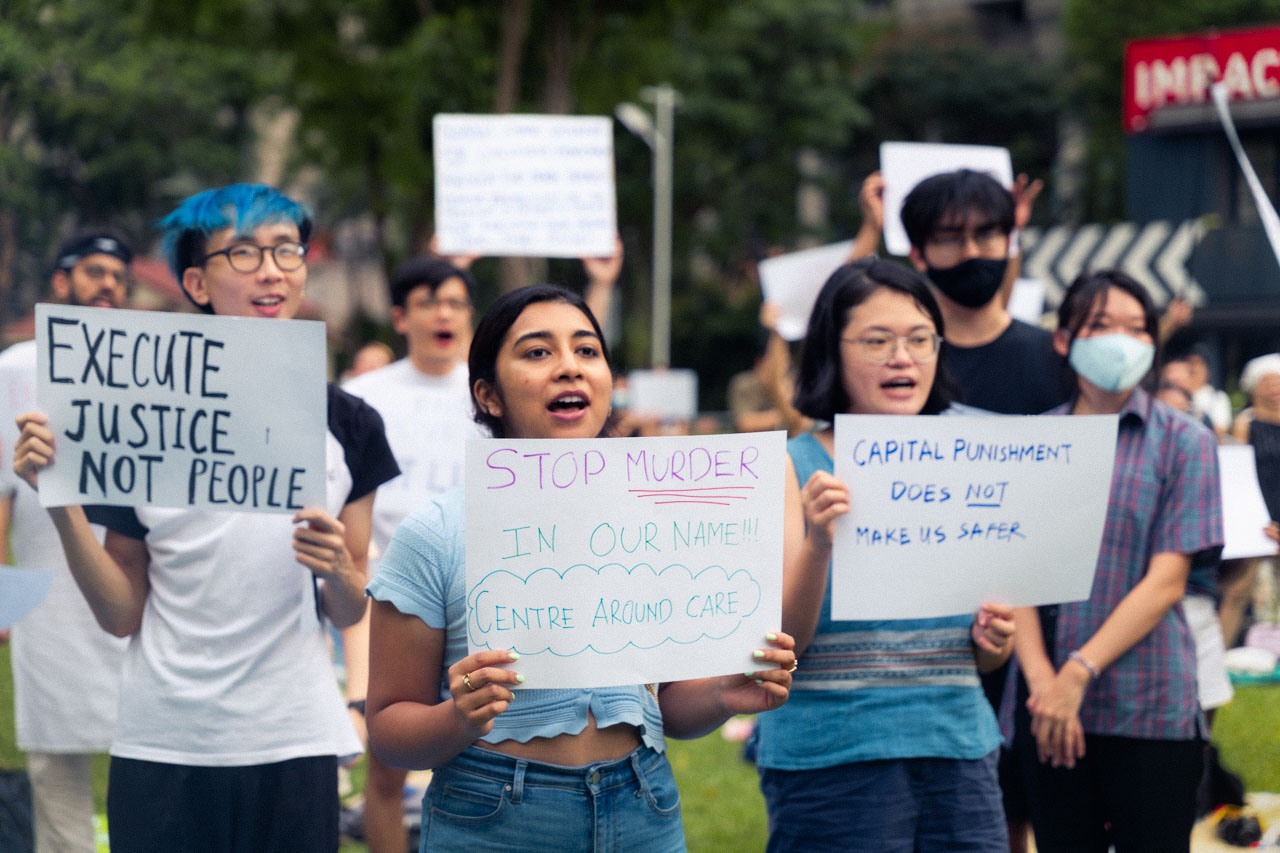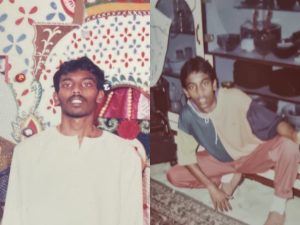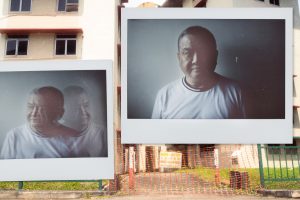All images: Stephanie Lee for Rice Media
In Singapore, protests, riots, and demonstrations are often lumped together, suggesting an intention to revolt against the powers that be and overtly display civil disobedience. Over the years, some local protestors also had run-ins with the law when they held illegal assemblies without permits, further vilifying protests within the national consciousness.
Still, there’s one place in Singapore where such dissent is legal (pending registration with the National Parks Board, of course). At the Speakers’ Corner at Hong Lim Park, demonstrations are par for the course and it’s the least likely place to spot a parent with a child—especially when a protest is ongoing.
That’s why I was taken aback to find Stephanie Chok and her school-going son at April 3rd’s protest against the death sentence. But, of course, the independent researcher would probably disregard the above characterisation of protests as balderdash, especially as a mother who cradled her son—an infant then—to the last death sentence protest about a decade ago.
Now he’s 10, and both are back in the same park protesting for the same cause. Holding onto her son’s hand as she spoke, Dr Chok, 49, said: “We had a conversation about what the death penalty is, and I tried to explain it to him [her son]. And he was quite upset.”
“He was quite sad that people were actually killed. Today, when I was coming to the event, I asked if he wanted to come with me. And he said he would. I wanted him to listen to the speeches and understand what people are opposed to,” she added.
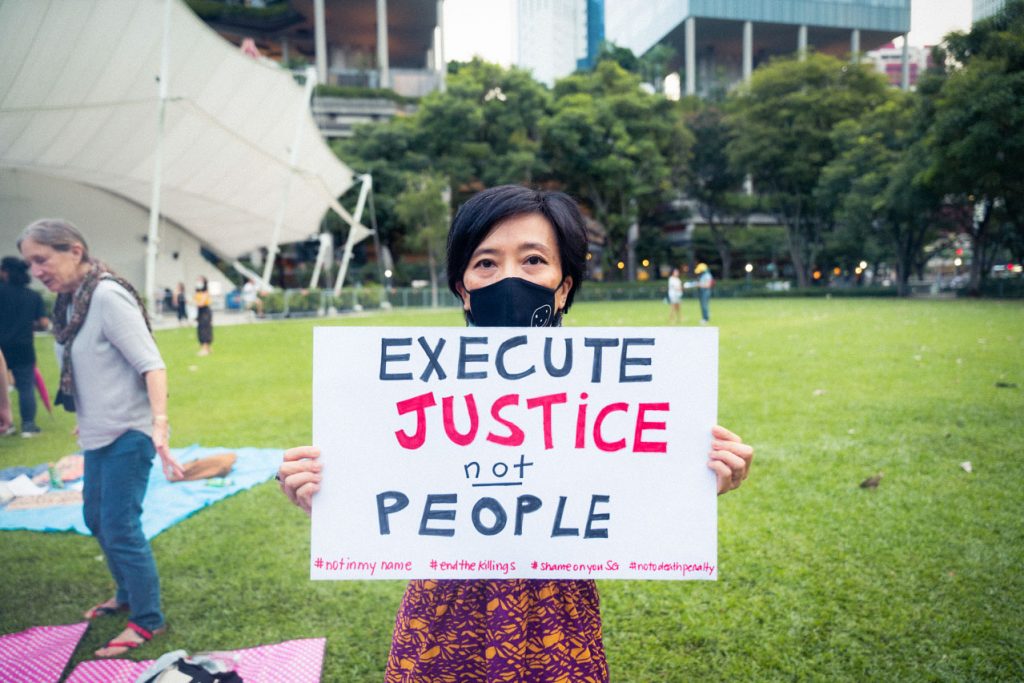
A Covid-regulated assembly
The attendance at the evening’s protest was a far cry from the last Speakers’ Corner event I attended before the pandemic. At the SG Climate Rally held in September 2019, more than 2,000 people turned up. In contrast, only about 475 people attended the Sunday protest in person, while over 100 viewers tuned in to the live stream. The full recording has since been taken offline.
It’s just as well—current Covid-19 rules dictate that the size of the crowd cannot exceed 950 people at any point in time. The showers before the protest could also be a factor, with the wet mushy ground at the location deterring those who had initially intended to participate.
Still, the turnout exceeded the expectations of the organiser, Jolovan Wham. The activist and social worker told me that past public events relating to the death penalty never saw such a huge crowd.
Maybe this was why Kirsten Han, an activist who spoke at the protest, was pessimistic about the turn-out while filling up the necessary paperwork for the event. Fifty people—this was how many people Ms Han had estimated to turn up, as she listed the number in her NParks registration form.
Smiling awkwardly, she also shared how they had printed slogan sheets for circulation among protesters, but there weren’t enough to get around. It’s a happy problem, she admitted.
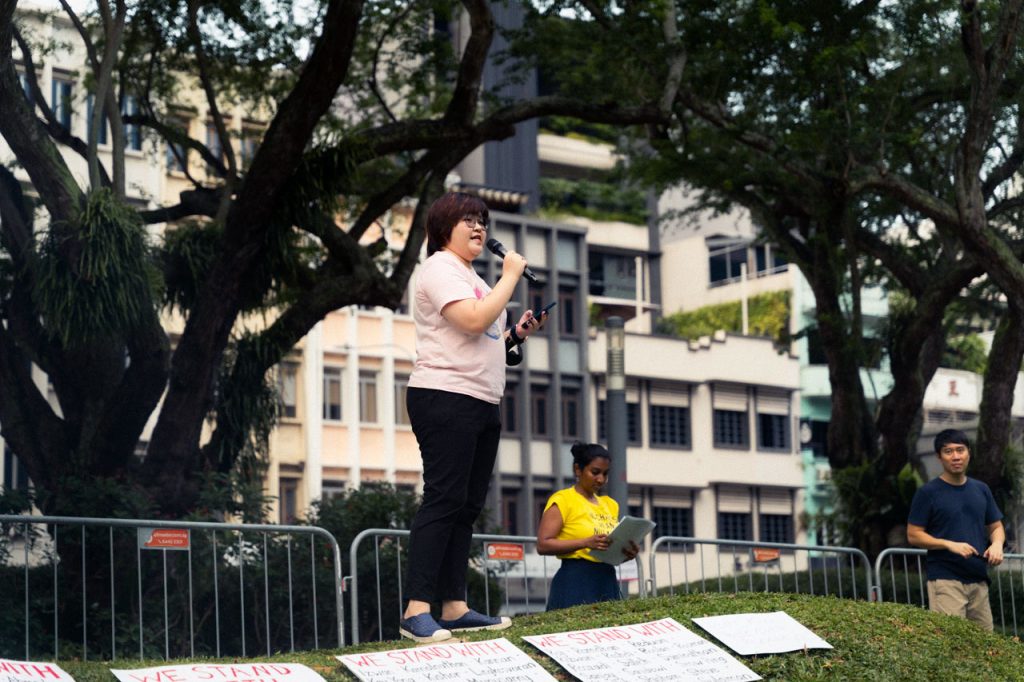
In attendance at the protest
As the protest kicked off at 5.30 PM, I began to observe the profiles of the attendees. Many were young Singaporeans, gathering on their picnic mats in small groups of less than 10, being careful to ensure a one-metre distance between groups. Some had their masks off since they are now optional outdoors. Surprisingly, no law-enforcement officers nor police drones were spotted patrolling the park.
At the back of the venue, the family of executed death-row prisoner Abdul Kahar Othman was present. Among them was Mr Abdul Kahar’s younger brother Abdul Mutalib, who told Ms Han, “It’s over for my brother. Now we fight for everyone else.” Mr Abdul Kahar, 68, was hanged on March 30 in Changi Prison.
The protesters held up the placards they designed using stationery provided by the organiser, joined by some notable activists in the crowd. In attendance were Lune Loh, former Internal Security Act detainees Tan Tee Seng, Teo Soh Lung, Low Yit Leng, former The Online Citizen editor Terry Xu, and Singapore Democratic Party’s chairman Paul Tambyah. There were also activists, such as Kokila Annamalai, from the Transformative Justice Collective who helped out at the event.
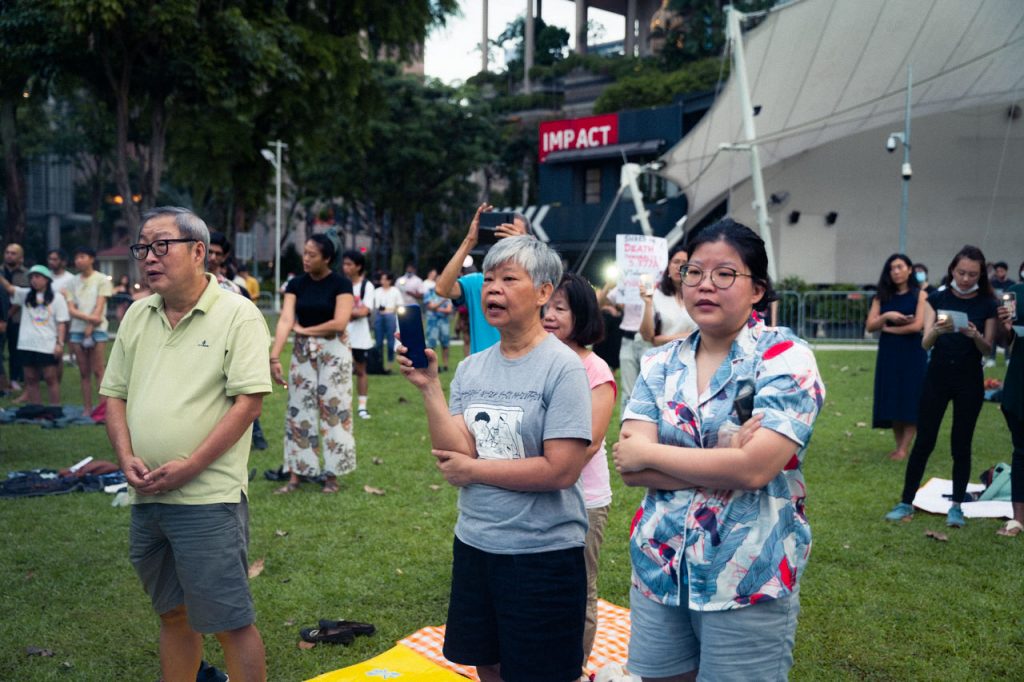
Unsurprisingly, some of these activists were regular attendees of events held at Speakers’ Corner before the pandemic forced its temporary closure for two years. But some are new to public assemblies, such as engineer Keith C. Before this, the 29-year-old had only attended the annual Pink Dot rally, which, if you asked those who had participated, would know that the event felt more like a festival than anything else.
When I saw Keith, he wasn’t holding any protest placard, which came as no surprise as he told me that he’s ambivalent on the death sentence issue. Keith understood the reasons for and against the punishment—he was here to “take in this side of the argument”.
“It’s good to see people united for a cause and are unafraid to voice out their views,” he said.
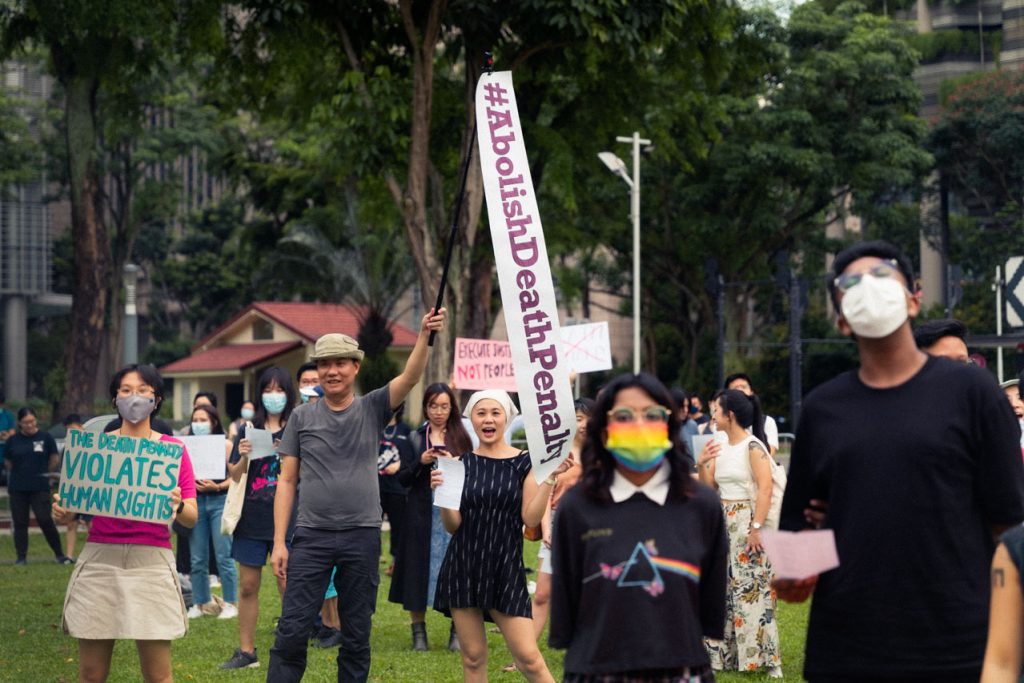
The fearlessness espoused by the protestors could be heard in the loud chants they echoed—“No more blood on our hands!”—and the placards they made and held up high. Among the numerous placards was one that read, “Capital punishment is the most premeditated of murders”.
This universal nature of life and death of the death sentence united protestors across genders, races, and even nationalities. While NParks has strict rules barring foreigners from participating in cause-based events at Speakers’ Corner unless they have a police permit (read: foreign interference), it didn’t deter some of the nearly 30 observers outside the barricaded area from watching from the periphery.
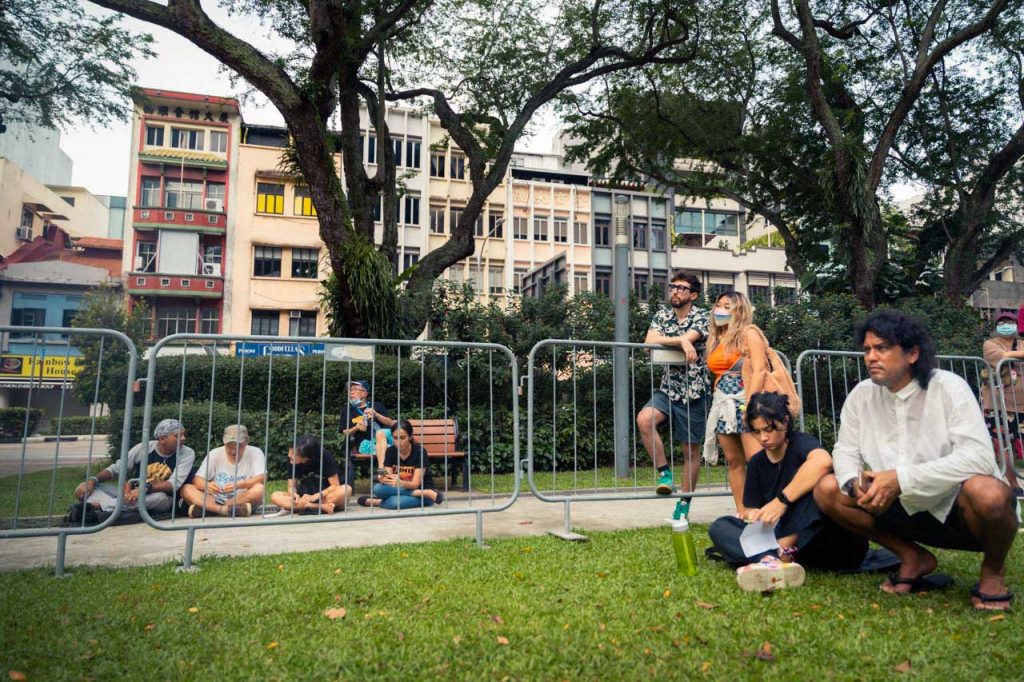
Beyond gender, race, and even nationality
It’s now 6.45 PM. Near the semi-circular outdoor stage of Hong Lim Park was a 19-year-old Guatemalan student, holding onto a can of cola, her arms hanging out on the metal barricade. Osmos is a first-year undergraduate student at an international school who arrived in May last year. She came from a Latin American country where drug trafficking is rampant, with the state conducting extrajudicial killings on some of these traffickers.
But Osmos brought up a valid point worth thinking about as we mull over the death penalty, specifically on drug offences, which constitute 59 of the 62 prisoners currently on death row, according to data by Transformative Justice Collective.
She said that in Guatemala, those caught or killed are often the mules and not the masterminds. “All the drug lords have to do is replace the runner with another person, and the problem continues,” she said. This is an unresolved issue not unique to Guatemala.
To the left of Osmos was her schoolmate Jell, an 18-year-old Indonesian, who chimed in and labelled the death penalty as the “brutal murder of an individual that is not unrelated to systemic racism.”
Systemic racism and its association with the death sentence were also hinted at by lawyer Charles Yeo, as he stood on the grassy hump and gave his impassioned speech. Gesturing aggressively towards the posters in front of him, filled with names of death row prisoners, he shouted: “Are they Chinese and rich individuals? They are all Malay and Indian men who are our brothers. They don’t deserve to die!”
Theatrics vs constructive ideas
Mr Yeo said he felt strongly about the death penalty his whole life, and this passion was reflected in his advocacy during some parts of his speech.
Still, he veered slightly from the original anti-death penalty agenda when he seemed to be using the pulpit to pursue his personal vendetta at the incumbent—given his chairmanship in the Reform Party (he stepped down from it recently), his contest in the Prime Minister’s Ang Mo Kio constituency in General Election 2020, and his brush with the law in January (he alleged the charges as politically-motivated).
“The capitalists, the AGC (Attorney-General’s Chambers), and Lee Hsien Loong (the Prime Minister)—they deserve to die,” Mr Yeo hollered, his finger pointing towards the sky fiercely. It was met with a moment of stunned silence by the crowd before he added, softly, “Figuratively, of course, or the next day you will see that I get charged.”
Other speakers like Ms Han and LGBTQ advocate Elijah Tay had milder approaches. Still, they only went far enough to explain ad-nauseam the cruelty behind capital punishment, peppered with expressions that tugged the protesters’ heartstrings and made for effective theatrics when everyone held their placards up high.

“Our state is so obsessed with death,” Mx Tay said.
“In every society with the death penalty, this act of state violence spreads pain and grief and trauma that ripples out beyond the confines of execution chambers into the hearts of families and throughout the community,” Ms Han said.
These are strongly-worded soundbites that few would disagree. Compassion, care, mercy, and justice are timeless values humans should abide by. But policy-making is more complex than that.
Unfortunately, amid impassioned virtue-signalling, most speakers failed to provide robust alternatives to capital punishment that would eradicate state-sanctioned violence as they wished.
Still, perhaps it’s unreasonable to expect these activists to discuss intricate details in a short two-hour protest, especially when they aren’t equipped with policy-making expertise. What’s the objective of this protest, then? Certainly, it wasn’t meant to be a pseudo-parliamentary debate to elucidate policy details.
“We had this protest so that people can come together in solidarity, so that people can express themselves, express their anger and also grief together… this is a time for people to collectively take a stand to say that we are against the death penalty,” Jolovan Wham told me after the protest.

Moving out of Twitterdom
These were the same sentiments Tan Mei Qi, 23, shared when I approached her after the event, a first for her. Now studying at the National University of Singapore, she didn’t expect much from this protest because she didn’t think most of Singapore was aligned with abolishing the death sentence.
“But I think this is something that is quite rare for us in Singapore, to be able to be in a space where everybody can be in solidarity with each other and to be able to speak openly about something that we really, really care about. I think that’s something that we haven’t had the opportunity for, especially as young people,” she said.
Her younger sister, Mei Qian, 21, was also with her at the protest. She had attended a similar event before, but it was held online. Like her sister, this was also her first physical protest.
“When it’s physical [protest], it really makes a lot of difference because you can see the people around, and the entire atmosphere is also very empowering. If we have solidarity, maybe there will be people power and you can make a difference,” said Mei Qian, who is also an NUS student.
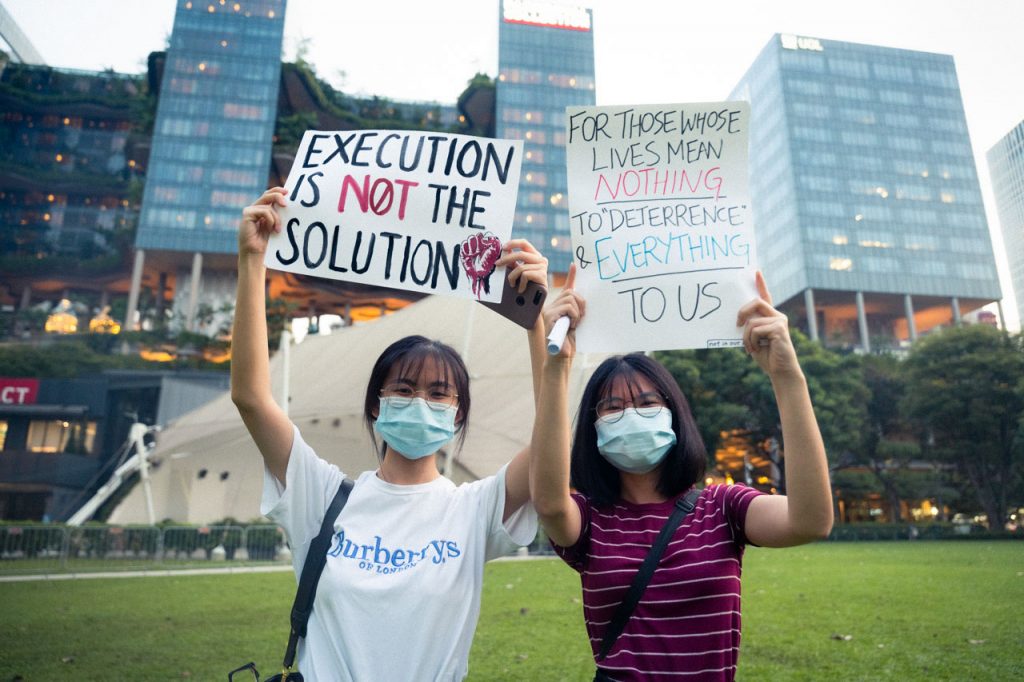
Whatever the medium, the need to vent frustrations over social and political issues remains, but having a physical gathering at the Speakers’ Corner and banding together for a cause, is a more powerful force of activism than just letting an issue seethe on Twitter.
Regardless of one’s position on the death sentence, the over-400 strong turnout on Sunday shows that young Singaporeans aren’t as apathetic as we think, nor are they merely keyboard warriors. Despite the prevalence of social media, which provides some shield of anonymity, there are still those who are brave enough to put their foot forward and make a stand.
If such protests are anything to go by, it bodes well for our future to have a more vocal generation, one willing to speak up on things they are unsatisfied with, fight for change, and make a difference.
We might not agree entirely with every cause they fight for, as some ideas are either too naive, lack maturity, or don’t consider the complexities of our world. Young people are too idealistic, some would say.
But isn’t idealism truly what being young is all about?
